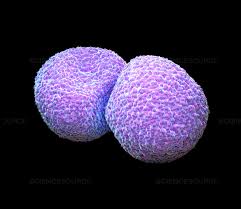Blog
Streptococcus pneumonia ~ S. pneumonia
S. pneumonia is a bacteria that can cause all kinds of trouble in young children and older adults (>65y). It is a common bacteria found in our nasal passages and this is how it causes trouble. Read on to learn more!


Photos: electron microscope pictures of S. pneumonia bacteria
There are about 90 different strains of Steptococcus pneumonia bacteria and about 13 of these strains cause illness. Most illness caused by this bacteria is mild and non-invasive such ear infections, sinus infections and pneumonia. However, pneumonia can become a more severe illness. Worldwide, half a million children under age 5 years die from S. pneumonia illness primarily due to pneumonia. Most of these deaths occur in developing nations. In the United States, almost a million people experience illness from this bacteria with about 400,000 hospitalizations yearly.
S. pneumonia bacteria can cause invasive and non-invasive disease. Invasive means that bacteria are present in spaces that are normally sterile. Invasive infections are meningitis (brain/spinal cord infection), empyema (infection in the cavity surrounding the lungs), pericarditis (infection around the heart) and bacteremia (infection of the blood stream) and joint or bone infections.
Meningitis - fever, chills, nausea, vomiting, headaches, stiff neck; in babies, poor feeding, irritability, vomiting and decreased alertness
Most severe invasive disease caused by S. pneumonia bacteria.
This can be a difficult illness to treat due to antibiotic resistance
Can cause hearing loss and developmental delays
About 6% of children will die from this infection
Bacteremia- decreased alertness, high heart rate, fever, chills, pain, clammy skin
This complication can occur secondary to pneumonia
Death in about 10% of children
Pneumonia- fever, chills, shortness of breath, chest pain, cough
Usually responds to antibiotics
Not considered invasive unless complications occur
Ear/Sinus infections - fever, pain, cough
Usually respond well to antibiotics
Not considered invasive
About 75% of children have S. pneumonia bacteria in their nasal passages starting at age 6 months and this can last from 3 months to one year. Up to 60% of school aged children carry the bacteria in their nasal passages. Colonization of the nasal and throat passages decreases with age as a person develops antibodies to the varying strains of S. pneumonia bacteria. By teenage years, only 25% of people are colonized and only about 5-10% of adults who are not routinely around children are colonized.
A carrier state is necessary for the transmission of the bacteria. S. pneumonia infections are most common in the winter and early spring when other respiratory illness are prevalent. Transmission of the bacteria occurs with exposure to respiratory secretions from sneezing and coughing.
S. pneumonia is the most common cause of bacterial illness in young children. Invasive disease is most common under the age of 5y and especially under the age of 2years. This is because of an immature immune system that cannot create antibodies effectively against this type of encapsulated bacteria. In addition, this younger age group is routinely exposed to the bacteria due to high rates of colonization in the nasal passage.
Older adults over the age of 65 years are particularly susceptible to S. pneumonia illness as they are not able to effectively mobilize antibodies to fight these infections and they are more likely to get invasive disease as well.
Prevention: Prevnar 13 vaccine and Pneumovax 23 vaccine
The rate of invasive disease and death from S. pneumonia has dropped dramatically with the advent of these two vaccines. Prevnar 13 is recommended for all children starting at age 2m and protects against the 13 most common strains that cause illness. Pneumovax vaccine is recommended for all adults over the age of 65 years and has added protection for 23 strains of S. pneumonia bacteria.
Vaccination is the best protection against illness from this common bacteria!
Grab the Wholistic Medicine Cabinet guide - it's a great resource to a well-stocked medicine cabinet with natural remedies. Just go to www.wholekidspediatrics.com/yoga-and-wellness, drop your email in the pop-up window and you will receive this downloadable ebook to your email address. Enjoy!
